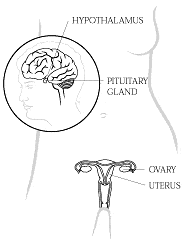If you are a woman with irregular periods, it’s probably something you’ve been dealing with since long before you were ready to have children. Now that you’re trying to get pregnant, those irregularities, which used to be just an annoyance, can become more anxiety provoking.
“Many patients I see don’t know what’s going on with their periods,” says Dr. Melissa Esposito of Shady Grove Fertility’s Frederick office. “They are anxious when they come into my office, and they think they won’t be able to conceive.”
The reason women worry is because menstruation is tied to ovulation. Ovulation is the process whereby the ovary releases a mature egg every month which, under the right circumstances, may be fertilized. This process is crucial for conception to take place. No egg, no pregnancy. But Dr. Esposito says problems with ovulation are common and not an insurmountable obstacle to pregnancy.
“I reassure my patients that we can usually figure it out,” she says. “There’s always a reason why ovulation has ceased or become irregular. Once we know the reason, we can almost always treat it. If there are no other causes of infertility present, such as blocked tubes or an abnormal semen analysis, almost all of these patients can achieve pregnancy.”
In fact, women with ovulation disorders often have successful outcomes with simple treatments like lifestyle changes and oral medications. Even if they need to do more advanced treatments like IVF, they have a very high rate of success. For women under the age of 37, the success rates are 55-60% per IVF cycle, even with the transfer of only one excellent quality embryo at a time.
Ovulation 101
To understand ovulation disorders, it helps to first look at how a normal ovulation cycle occurs. Women are born with a finite number of eggs, each inside its own egg follicle. The eggs exist inside the ovaries, which are controlled by hormones produced by the pituitary gland, namely Follicle Stimulating Hormone (FSH) and Luteinizing Hormone (LH).
FSH is the hormone responsible for stimulating one follicle each month to start developing a mature egg. Once the follicle reaches about 2cm in size and is secreting a certain amount of estrogen, the pituitary gland then sends out a surge of the other hormone, LH, which results in the mature egg being released from the follicle.
If ovulation is not occurring in a regular, timed fashion, it is likely that the ovaries and the pituitary gland are not communicating correctly.
Identifying the Problem
“We always look closely at thyroid function,” says Dr. Esposito, “because the thyroid gland works closely with the pituitary gland in reproduction.” Hypothyroidism, a condition in which the thyroid gland does not make enough thyroid hormone, tends to be the thyroid abnormality seen most commonly in women.Simple blood tests are the most effective method for finding the cause of this miscommunication. All women being diagnosed for infertility do the same battery of tests that check the levels of hormones important to fertility. Within the results are some of the common causes of ovulatory dysfunction.
“When the thyroid is not keeping up with the metabolic demands of the body,” says Dr. Esposito, “patients will often have cycle irregularity as well as symptoms such as cold intolerance, weight gain, hair loss and fatigue. This is very easily treated with thyroid hormone replacement.”
“We also check prolactin levels with a blood test,” Dr. Esposito adds. Prolactin is the hormone that, among many other functions, primes the breasts for breastfeeding. If a woman’s prolactin level is high even in a non-pregnant state, it can cause cycle irregularity.
These patients may also have an MRI done of the pituitary gland since patients with an elevated prolactin level can also have a small collection of cells in the pituitary gland called an adenoma. “These are normal prolactin secreting cells that grow into a hyperfunctioning unit and cause prolactin elevation and irregular cycles,” explains Dr. Esposito. “This can also easily be treated with medication.”
In addition to these tests, a detailed medical history will help round out the picture of the patient. Dr. Esposito says questions related to symptoms like acne, facial hair and weight gain are particularly important in diagnosing the most common ovulatory disorder, Polycystic Ovary Syndrome (PCOS). “The symptoms of PCOS are very bothersome to women, but they often don’t realize they are connected to the ovulation disorder until I ask them about these particular symptoms.” says Dr. Esposito.
Getting a Complete Picture of Fertility
Women with ovulation disorders often assume that it is the sole cause of their infertility. In fact, studies have shown that many of these women have additional causes of infertility, including a male factor for infertility within the couple.
“Before you start down the road of fertility treatment, it’s really important to do a complete infertility workup, including testing of the male partner,” says Dr. Esposito. “If we get you ovulating again, only to find out that you have blocked fallopian tubes or your partner has a low sperm count, then just ovulating won’t work for you.”
Included in the complete workup is a semen analysis for the male partner and an HSG for the female partner. An HSG is a test that uses x-ray technology to show the health and shape of the uterus and fallopian tubes. An ultrasound is also standard for the female partner with hormone testing to get an idea of the health of her eggs and ovaries. “We also recommend a series of genetic blood tests as well,” adds Dr. Esposito.
Because there are a number of different causes of ovulation disorders, there isn’t a single treatment that works for everyone. Below, the most common ovulatory disorders and their treatments are described.
Polycystic Ovary Syndrome (PCOS)

PCOS is the most common ovulatory disorder, affecting 85% of women with ovulatory dysfunction. PCOS patients have an abnormal imbalance of the hormones FSH and LH that are secreted from the pituitary gland. These patients will often have very infrequent and irregular periods. They can also have acne and hair growth on the face, chin, chest and abdomen. This is the result of LH hypersecretion from the pituitary gland throughout the cycle.
Due to the fact that there is either very infrequent ovulation or no ovulation, there can be a very dense collection of small egg follicles, or cysts, on the ovaries that look like pearls. Each of these small follicles produces some estrogen, and that estrogen can act on the uterine lining to cause it to become thick. This, in combination with the fact that it does not undergo a regular shedding every month, can cause women to have very irregular bleeding and even anemia.
Another problem related to PCOS is insulin resistance. The insulin problem can result in unexplained weight gain and obesity. While many people consider obesity to be a main symptom of the disorder, 1/3 of women with PCOS are a normal weight.
Treating PCOS
If there are no other causes of infertility, such as low sperm count or blocked tubes, women with PCOS can start treatment with a simple oral medication and timed intercourse.
The medication most commonly used is Clomiphene, also called Clomid. Clomiphene is an antiestrogen and as a result of taking it, there is an increased production of FSH and LH from the pituitary gland causing the development of one or more egg follicles. While the patient is taking Clomid, bloodwork and ultrasound are used to monitor the progress of the follicles. Once the follicles reach a certain size, an injection of a medication that causes ovulation is given, and the patient can be told the best time to have intercourse to achieve pregnancy. Monitoring is always done to help time the cycle precisely and to help decrease the risk of multiple pregnancy. After fertilization attempts, progesterone may be taken by the patient to support a possible pregnancy.
“If the couple does a few cycles of Clomid alone without success, then we would likely recommend adding an injectable form of the FSH hormone. The injectables can add strength to the cycle,” says Dr. Esposito. “If the timed intercourse cycles are not working or the couple has any issues with their semen analysis, then we would recommend Intrauterine Insemination or IUI.”
With IUI, the semen sample can be specially prepared in a process called “washing” so that only the healthiest sperm are placed into the top of the uterus. This is timed to occur a few hours before ovulation occurs so that the sperm are waiting there for the egg to be released. The typical success rates with ovulation induction and IUI are about 15% – 20% per cycle with higher chances among younger women and lower chances for older women.
Dr. Esposito adds, “While many of our patients have success with the lower tech methods, if IUI is not successful within about 3-4 cycles, then it may be necessary to move on to In Vitro Fertilization (IVF).” At Shady Grove Fertility, patients with ovulatory disorders, including PCOS, have a 55% chance of successfully having a baby per IVF cycle if they are less than 37 years old with a normal ovarian reserve.
Regardless of their treatment path, PCOS patients who are obese can increase their chances of pregnancy by losing weight. “Losing just 5-10% of body weight has been shown to markedly improve the chances of pregnancy,” says Dr. Esposito. Some doctors prescribe a drug called Metformin for these patients, which increases the body’s response to insulin. Treating glucose intolerance and losing weight has the added benefit of reducing a patient’s long-term risk for diabetes and heart disease.
Hypothalamic Amenorrhea

While many women with PCOS are overweight, women who are underweight often suffer from another ovulatory disorder calledHypothalamic Amenorrhea, which accounts for about 10% of ovulatory disorders. “These women don’t have the body fat necessary to sustain ovulation every month,” says Dr. Esposito.
If a woman has a very small amount of body fat or is severely underweight, the body perceives itself to be starving and shuts down all non-essential bodily functions, reproduction included. In this case, the hypothalamus, an area at the base of the brain that regulates the pituitary gland, stops producing and releasing the hormone GnRH or Gonadotropin Releasing Hormone. GnRH is responsible for the release of FSH and LH, hormones critical to ovulation. Due to the fact that GnRH is either not being produced or being produced in negligible amounts, the LH and FSH from the pituitary gland are often undetectable when checked on blood tests.
Any type of chronic stress that results in low body fat, such as an eating disorder, excessive exercise, narcotic abuse or chronic disease can lead to Hypothalamic Amenorrhea.
Treating Hypothalamic Amenorrhea
Like PCOS patients, women with Hypothalamic Amenorrhea can also use lifestyle changes to improve their chances of pregnancy. “If the woman stops over-exercising or gains weight, ovulatory function may return to normal on its own,” says Dr. Esposito. However, lifestyle changes can be difficult for patients to achieve and take time, so there is a balance between the increase in fertility due to the weight change and the loss of fertility that occurs with aging. Also, even if patients do gain weight, they may never restore ovulatory function.
Another way to treat this condition is to give the patient the FSH and LH hormones that her body is not producing. A cycle of timed intercourse or IUI with injectable medications is often successful for these patients. Like patients with PCOS, 3 cycles of IUI with injectables would be recommended before moving on to more complicated treatments like IVF.
“Once we treat the hormone imbalance,” says Dr. Esposito, “women with Hypothalamic Amenorrhea have an excellent chance of getting pregnant.”
Hyperprolactinemia
A smaller group of women have a disorder in which the pituitary gland produces excessive amounts of the hormone prolactin. Prolactin normally circulates in the blood in small amounts in women who are not pregnant and in large amounts during pregnancy and right after birth.
Hyperprolactinemiacan cause irregular or no ovulation, resulting in infertility.
One of the most common causes of hyperprolactinemia is a benign tumor growing on the pituitary gland – the gland that produces prolactin. Other causes of excess prolactin production may be an underactive thyroid (hypothyroidism) or certain medications the patient may be taking. Sometimes, the cause is unknown.
Treating Hyperprolactinemia
“Thyroid conditions are fairly easy to treat with medication,” says Dr. Esposito, “and once it’s treated, the amount of prolactin in the blood may go back to a normal level.” If the patient has a benign tumor on her pituitary gland, or the cause of the hyperprolactinemia is unknown, treatment with medication can reduce the prolactin levels. This medication usually causes pituitary tumors to shrink as well.
“Just like other ovulation disorders, once we get the woman ovulating, she has the same chance as anyone else to get pregnant,” says Dr. Esposito. In this case, the treatment recommendations would be similar to the ones given to women with other ovulatory disorders – start with low tech treatments with medications and move up to more advanced treatment if those cycles are unsuccessful.
“Again,” says Dr. Esposito, “if the ovulatory disorder is the only problem the couple has, then their chances for pregnancy are very good.”
Pregnancy is on the Horizon
If you are one of the thousands of women with irregular periods or problems with ovulation, seeing a fertility specialist can give you confidence and hope. When you have an accurate diagnosis, you’ll be able to create a treatment plan with multiple avenues for success.
“Once women with ovulatory disorders learn why they are having trouble conceiving and what we can do to help, they feel a lot more positive about their chances of getting pregnant,” says Dr. Esposito. “The important thing is to see a fertility specialist for a complete diagnosis and get started with treatment as soon as possible.
If you have more questions about ovulatory disorders or would like to schedule your new patient appointment, please call 1-888-761-1967 or click here.





